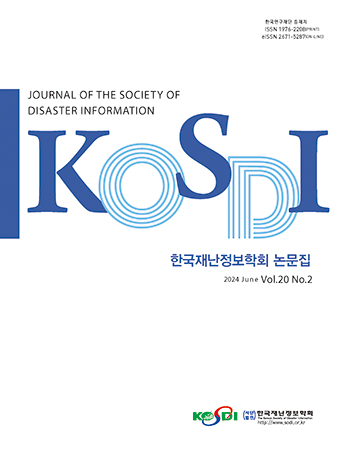Research Article
Abstract
References
Information
Purpose: In recent, mobile technology, as an axis of the fourth industry paradigm, is evolving into our daily life, economic activities and disaster safety management. However, since the location information service is insufficient, it is difficult to response the emergency situation adequately in the golden time. The purpose of this study is to propose a method to fine precisely the location of people who are in need of an emergency in the event of accidents and disasters. Method: This study investigates and compares existing literature and safety apps for national index number NFC application development. In addition, the system structure and the design method through the element technology through analysis of necessary function of the demander were carried out. Results: The results of this study were developed as a design and system that can be implemented in both direction and function to inform the location for emergency situation or disaster reporting in mobile. Conclution: It is possible to provide the disaster safety location service which can be utilized by the citizens in case of crisis by unifying the address system and integrating the location information using NFC.
연구목적: 최근 모바일 기술은 우리의 일상생활과 경제활동 및 재난안전관리에 이르기까지 4차산업 패러다임의 축으로서 확장되고 있다. 하지만 모바일 기기를 통한 위치정보 서비스 체계가 미흡하여 재난안전 위급상황에서 신속한 대응이 어렵다. 본 연구에서는 사고 및 재난으로 인한 응급상황 발생 시 요구조자의 정확한 위치 파악과 위치체계를 일원화 하여 대국민 재난안전 서비스를 하는데 목적이 있다. 연구방법: 본 연구의 방법은 국가지점번호 NFC 활용 앱 개발을 위하여 기존 문헌 및 안전관련 앱의 조사와 비교 분석을 한다. 또한 요구조자의 필요기능 분석을 통한 시스템 구성과 요소기술을 통한 설계 방법으로 진행하였다. 연구결과: 본 연구의 결과는 모바일에서 긴급상황 시 또는 재난 시 신고를 위하여 위치를 알릴 수 있는 기능과 양방향으로 구현할 수 있도록 설계 및 시스템으로 개발 하였다. 결론: 주소체계를 일원화하고 NFC를 활용한 위치정보전달 통합시스템을 개발하여 위기 시 국민이 쉽게 활용할 수 있는 재난안전 위치서비스를 제공 할 수 있다.
- Byeon, H.-S. (2017). A Study on Road Names in South Korea-Focusing on Ulsan Jung-gu. A thesis on Master’s Degree in Korean Education at Graduate School of Chinju national University.
- Disaster and Safety Management Basic Law (2019). Enforcement Decree, No.29498.
- Disaster and Safety Management Basic Law (2019). No.16301.
- http://news.khan.co.kr/kh_news/khan_art_view.html?artid=201411151431061&code=910100#csidx12adab77b226f9a885b474828daaca6
- http://www.safemap.go.kr/main/smap.do
- https://play.google.com/store/apps/details?id=kr.go.nema.disasteralert_new&hl=ko
- https://terms.naver.com/entry.nhn?docId=760776&cid=50324&categoryId=50324
- https://terms.naver.com/entry.nhn?docId=845959&cid=42346&categoryId=42346
- https://www.safetyreport.go.kr/#main
- Im, Y.-S. (2016). A Study on the Relationship Between Korean Unique Place Name and Road Name Address. A thesis on the Doctor Degree in Praxis Buddhism Major Department of Buddhist Studies at Graduate School of Joong-Ang Sangha University.
- Lee, J.H., Choi, H.C., Kim, E.J., Sung, K.H., Lee, J.E., Byun, S.S. (2011). “An Empirical Analysis for Enhancing Utilization of Emergency Communication System in Crisis.” Crisis Management Directory, Vol. 7, No. 5.
- Ministry of the Interior and Safety, Pronouncement 2012-351
- Road name address method (2011). No.10987.
- Road name address method (2017). No.14839.
- Publisher :The Korean Society of Disaster Information
- Publisher(Ko) :한국재난정보학회
- Journal Title :Journal of the Society of Disaster Information
- Journal Title(Ko) :한국재난정보학회논문집
- Volume : 15
- No :2
- Pages :282-291
- DOI :https://doi.org/10.15683/kosdi.2019.06.30.282




 Journal of the Society of Disaster Information
Journal of the Society of Disaster Information







